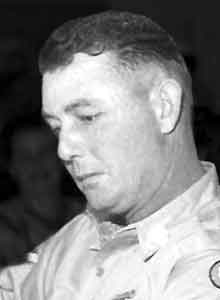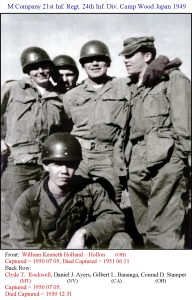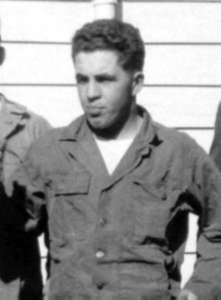Thomas Henry Berardi from Massachusetts, Worcester county.
Service era: Korea
Date of death: Unknown
Death details: On July 5, 1950, Task Force Smith, the first U.S. ground element to engage North Korean People’s Army (NKPA) troops, was defending a position north of Osan, South Korea. The Task Force’s goal was to delay enemy forces by blocking their movement down the road south from Suwon to Taejon, which was a major avenue of advance for the NKPA. That morning, the Task Force was engaged by a column of enemy tanks. The anti-tank weapons that the infantrymen employed were ineffective, and a large number of tanks broke through their position. Task Force Smith was forced to withdraw to the south, suffering heavy casualties in the process. Corporal Thomas Henry Berardi joined the U.S. Army from Massachusetts and was a member of B Company, 1st Battalion, 21st Infantry Regiment, 24th Infantry Division. He was captured by enemy forces during Task Force Smith’s withdrawal. CPL Berardi joined a group of prisoners who were marched to the “Apex Camps” in northern North Korea near the Yalu River, where he died of malnutrition, exhaustion, and pneumonia in July 1951. He was not identified among remains returned to U.S. custody after the ceasefire, and he is still unaccounted-for. Today, Corporal Berardi is memorialized on the Courts of the Missing at the National Memorial Cemetery of the Pacific.
Source: National Archives, Defense POW/MIA Accounting Agency

 Death details: On July 5, 1950, Task Force Smith, the first U.S. ground element to engage North Korean People’s Army (NKPA) troops, was defending a position north of Osan, South Korea. The Task Force’s goal was to delay enemy forces by blocking their movement down the road south from Suwon to Taejon, which was a major avenue of advance for the NKPA. That morning, the Task Force was engaged by a column of enemy tanks. The anti-tank weapons that the infantrymen employed were ineffective, and a large number of tanks broke through their position. Task Force Smith was forced to withdraw to the south, suffering heavy casualties in the process. Master Sergeant Harvey Thomas Vann, who joined the U.S. Army from Texas, served with C Company, 1st Battalion, 21st Infantry Regiment, 24th Infantry Division. His unit was part of Task Force Smith, and he was captured by enemy forces on July 5. He was marched to the Apex prison camps in North Korea, and died of exhaustion and pneumonia at the camp at Hanjang-ni in early January 1951. He was buried on a hillside just above the village; however, his remains were not identified among those returned to U.S. custody after the ceasefire. Today, Master Sergeant Vann is memorialized on the Courts of the Missing at the National Memorial Cemetery of the Pacific.
Death details: On July 5, 1950, Task Force Smith, the first U.S. ground element to engage North Korean People’s Army (NKPA) troops, was defending a position north of Osan, South Korea. The Task Force’s goal was to delay enemy forces by blocking their movement down the road south from Suwon to Taejon, which was a major avenue of advance for the NKPA. That morning, the Task Force was engaged by a column of enemy tanks. The anti-tank weapons that the infantrymen employed were ineffective, and a large number of tanks broke through their position. Task Force Smith was forced to withdraw to the south, suffering heavy casualties in the process. Master Sergeant Harvey Thomas Vann, who joined the U.S. Army from Texas, served with C Company, 1st Battalion, 21st Infantry Regiment, 24th Infantry Division. His unit was part of Task Force Smith, and he was captured by enemy forces on July 5. He was marched to the Apex prison camps in North Korea, and died of exhaustion and pneumonia at the camp at Hanjang-ni in early January 1951. He was buried on a hillside just above the village; however, his remains were not identified among those returned to U.S. custody after the ceasefire. Today, Master Sergeant Vann is memorialized on the Courts of the Missing at the National Memorial Cemetery of the Pacific. Death details: On July 5, 1950, Task Force Smith, the first U.S. ground element to engage North Korean People’s Army (NKPA) troops, was defending a position north of Osan, South Korea. The Task Force’s goal was to delay enemy forces by blocking their movement down the road south from Suwon to Taejon, which was a major avenue of advance for the NKPA. That morning, the Task Force was engaged by a column of enemy tanks. The anti-tank weapons that the infantrymen employed were ineffective, and a large number of tanks broke through their position. Task Force Smith was forced to withdraw to the south, suffering heavy casualties in the process. Private First Class Neil Roger Scott, who joined the U.S. Army from Ohio, served with the Medical Company of the 21st Infantry Regiment, 24th Infantry Division. His unit was part of Task Force Smith, and he was captured by enemy forces on July 5 and marched to the Apex prison camps in North Korea. He died of malnutrition and pneumonia at Hanjang-ni on an unspecified day in January 1951. Although he was buried near the camp, his remains were not identified among those returned to U.S. custody after the war. Today, Private First Class Scott is memorialized on the Courts of the Missing at the National Memorial Cemetery of the Pacific.
Death details: On July 5, 1950, Task Force Smith, the first U.S. ground element to engage North Korean People’s Army (NKPA) troops, was defending a position north of Osan, South Korea. The Task Force’s goal was to delay enemy forces by blocking their movement down the road south from Suwon to Taejon, which was a major avenue of advance for the NKPA. That morning, the Task Force was engaged by a column of enemy tanks. The anti-tank weapons that the infantrymen employed were ineffective, and a large number of tanks broke through their position. Task Force Smith was forced to withdraw to the south, suffering heavy casualties in the process. Private First Class Neil Roger Scott, who joined the U.S. Army from Ohio, served with the Medical Company of the 21st Infantry Regiment, 24th Infantry Division. His unit was part of Task Force Smith, and he was captured by enemy forces on July 5 and marched to the Apex prison camps in North Korea. He died of malnutrition and pneumonia at Hanjang-ni on an unspecified day in January 1951. Although he was buried near the camp, his remains were not identified among those returned to U.S. custody after the war. Today, Private First Class Scott is memorialized on the Courts of the Missing at the National Memorial Cemetery of the Pacific. Death details: On July 5, 1950, Task Force Smith, the first U.S. ground element to engage North Korean People’s Army (NKPA) troops, was defending a position north of Osan, South Korea. The Task Force’s goal was to delay enemy forces by blocking their movement down the road south from Suwon to Taejon, which was a major avenue of advance for the NKPA. That morning, the Task Force was engaged by a column of enemy tanks. The anti-tank weapons that the infantrymen employed were ineffective, and a large number of tanks broke through their position. Task Force Smith was forced to withdraw to the south, suffering heavy casualties in the process. Corporal Clyde Thomas Rockwell, who joined the U.S. Army from Montana, served with M Company, 3rd Battalion, 21st Infantry Regiment, 24th Infantry Division. His unit was part of Task Force Smith, and he was captured by enemy forces on July 5 and forced to march to the Apex prison camps in North Korea. He died of malnutrition and dysentery at the camp at Hanjang-ni on an unspecified day in late 1950, and was buried near the village. His remains were not identified among those returned to U.S. custody after the ceasefire, and he is still unaccounted for. Today, Corporal Rockwell is memorialized on the Courts of the Missing at the National Memorial Cemetery of the Pacific.
Death details: On July 5, 1950, Task Force Smith, the first U.S. ground element to engage North Korean People’s Army (NKPA) troops, was defending a position north of Osan, South Korea. The Task Force’s goal was to delay enemy forces by blocking their movement down the road south from Suwon to Taejon, which was a major avenue of advance for the NKPA. That morning, the Task Force was engaged by a column of enemy tanks. The anti-tank weapons that the infantrymen employed were ineffective, and a large number of tanks broke through their position. Task Force Smith was forced to withdraw to the south, suffering heavy casualties in the process. Corporal Clyde Thomas Rockwell, who joined the U.S. Army from Montana, served with M Company, 3rd Battalion, 21st Infantry Regiment, 24th Infantry Division. His unit was part of Task Force Smith, and he was captured by enemy forces on July 5 and forced to march to the Apex prison camps in North Korea. He died of malnutrition and dysentery at the camp at Hanjang-ni on an unspecified day in late 1950, and was buried near the village. His remains were not identified among those returned to U.S. custody after the ceasefire, and he is still unaccounted for. Today, Corporal Rockwell is memorialized on the Courts of the Missing at the National Memorial Cemetery of the Pacific. Death details: On July 5, 1950, Task Force Smith, the first U.S. ground element to engage North Korean People’s Army (NKPA) troops, was defending a position north of Osan, South Korea. The Task Force’s goal was to delay enemy forces by blocking their movement down the road south from Suwon to Taejon, which was a major avenue of advance for the NKPA. That morning, the Task Force was engaged by a column of enemy tanks. The anti-tank weapons that the infantrymen employed were ineffective, and a large number of tanks broke through their position. Task Force Smith was forced to withdraw to the south, suffering heavy casualties in the process. Private First Class Wilbur Barlett Colford, who joined the U.S. Army from Maine, served with B Company, 1st Battalion, 21st Infantry Regiment, 24th Infantry Division. His unit was part of Task Force Smith and he was captured by enemy forces on July 5, 1950. He was forced to march north to a temporary prison camp near Manpo, North Korea, where he died of exhaustion, exposure, and malnutrition in late October 1950. His remains were not identified among those returned to U.S. custody after the ceasefire. Today, Private First Class Colford is memorialized on the Courts of the Missing at the National Memorial Cemetery of the Pacific.
Death details: On July 5, 1950, Task Force Smith, the first U.S. ground element to engage North Korean People’s Army (NKPA) troops, was defending a position north of Osan, South Korea. The Task Force’s goal was to delay enemy forces by blocking their movement down the road south from Suwon to Taejon, which was a major avenue of advance for the NKPA. That morning, the Task Force was engaged by a column of enemy tanks. The anti-tank weapons that the infantrymen employed were ineffective, and a large number of tanks broke through their position. Task Force Smith was forced to withdraw to the south, suffering heavy casualties in the process. Private First Class Wilbur Barlett Colford, who joined the U.S. Army from Maine, served with B Company, 1st Battalion, 21st Infantry Regiment, 24th Infantry Division. His unit was part of Task Force Smith and he was captured by enemy forces on July 5, 1950. He was forced to march north to a temporary prison camp near Manpo, North Korea, where he died of exhaustion, exposure, and malnutrition in late October 1950. His remains were not identified among those returned to U.S. custody after the ceasefire. Today, Private First Class Colford is memorialized on the Courts of the Missing at the National Memorial Cemetery of the Pacific.